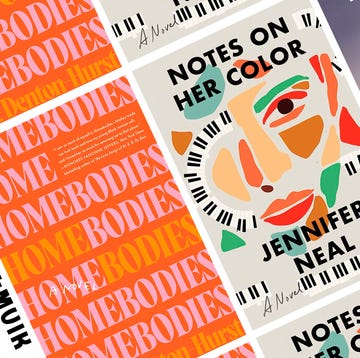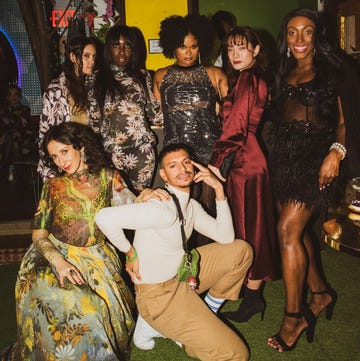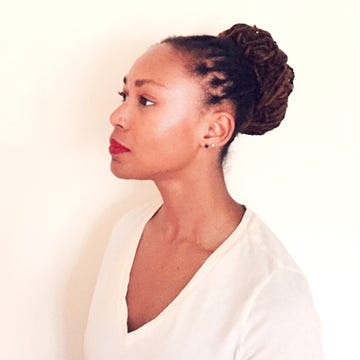I make pieces that reflect the journey I'm on. They are sculptural beings that look right back at me, and they help me learn about myself. I listen to myself, I listen to the ethers, I listen to the dimensions, and then I turn what I've been told into a being. Sometimes I don't get the message right away, but the process of making something and seeing the process of doing so reflected back at me helps me to transform the way I'm thinking about or navigating the world. Through this exchange with these beings that come through me, I'm building new neural pathways. Hopefully, when they're out in the world, they can help others do the same.
I'm from Santa Clara Pueblo in New Mexico. My mom chose to raise me and my other siblings here, but I'd go to my dad's house every other weekend in Santa Fe. He's white and is also an artist—a sculptor in bronze, wood, and metal. I went to the tribal day school for a little bit, and then I was homeschooled with my brother from fourth to seventh grades. Because of that, I was immersed in her world.
My mom has a permaculture institute; it's a nonprofit organization that's based on the study and practice of sustainable living systems like our ancestors'. We didn't have electricity. We grew our food. We ate our pets. We were homesteading. I didn't know it wasn't normal in lots of ways.
More From Harper's BAZAAR

My mom was also a contemporary artist within our community; she was a potter, but she also made sculptures using the traditional coil method. It's how we hand-build pottery, but she made people instead. She supported our family off her artwork. She would take her pieces to the Santa Fe Indian Market, and sell them and make the money for the year, which wasn't much. This created a neural pathway in my head that you can support your family off your art, like everybody does here.
Originally, I didn't want to work in clay. Then I went to the University of New Mexico, where I studied printmaking, and I took a ceramics course for an easy credit. I was like, "Wait a minute, I got this." I was really interested in youth culture in the late '90s, early 2000s. My passion was drawing the vibe that I was in and around, which involved things like hip-hop and graffiti. I was in a bunch of bands. I was in a hip-hop group. And later, I began skateboarding and singing in an experimental punk band. I started thinking, Oh, I could make these characters that I draw.
I started experimenting with, "What is my own personal experience of being a modern native in youth culture? What does that look like as someone who has a foot in numerous worlds and cares a lot about them?" Craft is a very spiritual process; clay is a super-receptive material. It knows when you're unhappy, it knows when you're happy, and then it reacts to your emotional state. I think I returned to clay, because it helped me be more self-aware.
I went to the Rhode Island School of Design for graduate school. When I got there, I started challenging the process of creating itself. I devised this methodology that I call slap slab. I throw the clay sideways until it's super thin, and then I build with it, layering pieces onto one another [for a shingled effect]. That forces you to be okay with the process itself. You can't go back and fix it or change it, because the walls are super, super thin. I also think about also the environmental impact of art making and how many resources we use. I try to make minimal waste. With slap-slab pieces, there's very little. But you have to be compassionate with what the piece creates itself to be, rather than have this idea of what perfect looks like and want it to fit that mold.
Much of my work back then was focused on this idea of a warrior and experimented with transforming what it could look like. My pieces had a lot of things tied onto them; they were empowered objects in lots of ways.
Because the slap slab is fragile, I coil-build most of my work, especially the big pieces. The technique comes easy to me, because I watched my mom do it over and over and over again. I think that that was a gift. I often think about our ancestral relationship to clay and the fact that it's embedded in our DNA.
I became a mom six years ago, and it changed my practice profoundly. After I gave birth, my pieces became softer and more feminine; I found power in bringing a life into the world. The patience and dedication necessary of a mother showed me what power, strength, fortitude, and grace really look like.
While I was navigating creating for my show, "Road Less Traveled," currently on view at Jack Shainman Gallery, I was allowing myself to look for an alternative to the major neural pathways that I have developed through my life. I realized that the judgments I've held around the concept of courage, for example, have been that it's confrontational, a denial of fear. What I've realized is that courage can sometimes look like vulnerability and humility in moments where we want to be in control. Wow, I can stay in my vulnerability and in my truth even in a scary situation? That's brave.
There's one piece in the show that's called Conjured Two, and it's a head that's sitting on a piece of wood with a cloud of ceramic rings on its forehead. It's about the ability to dream something, and then make it a reality. Specifically, Conjure Two is about a new studio I'm building, which is really a dream come true. The base is made from some of the pine scraps from the building process. It's very much an acknowledgement of the fact that something I really wanted is happening.
Another piece in the show that I think is really cool is Release. It's the tallest piece in the show. It was initially going to be three and a half or four feet, but when I started building it, it ended up getting taller and taller and taller. The idea behind it is about releasing all the thoughts and judgments we hold and allowing something new in. The piece has a necklace for arms and it's clasping at the ground, so it's in a very calm and graceful moment of being.
I don't use glaze on any of my work; the color of the clay is important to me because it's grounding. The markings I use all represent something, whether it's the plus sign, which is the star for guidance; the X, which is for protection; or animal tracks, which represent the path we're on.
I used to tie a lot of found objects onto my pieces; I have these collections of rusting metal washers and things. I've been making a lot of necklaces with found materials like stone, bone, glass, lava, wood, and leather. I really like the energy that they carry, because they reference our relationship with the natural world. More recently, I've been leaving them out and simplifying things, but I still use car parts often, because cars are important to me—I have a car shop—and they're also vessels.
I am the conduit for this work to be in the world. I always think that when I cut the eye slits out of the clay, they wake up. Sometimes it's really a powerful moment. I say, "Wow, hello, hello." I meet them for the first time, and I wonder what their journey will be. I have to trust that where they go is where they need to do work, because they are in control of their own existence. Where they go is where they wanted to go. There's a sense of faith, I think.
















